Letting Stories Inspire –
An anthropology course designed to examine the potential of comics and ethnographic methods.
The goal of this course was to focus on relations and networks of people, objects, and spaces in regards to health and medicine. We consider what it means- to anthropologists and to the people with whom we work – to tell stories of people’s lives through text and imagery. The course took place over two quarters in the 2012-2013 academic year and included having the students collect illness narratives, work with a local artist, and draw a comic of their own based on the illness narrative.
We used two books to guide our thinking. The first was Arthur Frank’s Letting Stories Breathe. As you might notice, the title of our final project Letting Stories Inspire was heavily influenced by this book. Combining the thinking of Donna Haraway and Bruno Latour, Frank asks us to think about the capacities of stories and how they are our companions.
The second book we used was Ivan Burnetti’s Cartooning: Philosophy and Practice. Burnetti’s text is a 15 week course on creating a comic. It includes a syllabus and a series of discussion and homework assignments that engage students to think about the relationship between words and image, the essential elements that need to be in a panel to create a story, and then how to actually visually represent that short story.
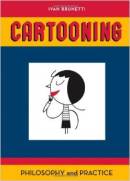
Students noticed one recurring practice that both books emphasized. This practice was to slow down. To take time to consider the context, observe the objects and interactions around you. For Frank, slowing down could enhance our ability to attend to multiple meanings, how a story impacted people in different ways. For Burnetti, slowing down allows us to see the objects that give meaning (or when rearranged, a completely different meaning) to the context.
During the two quarters 15 undergraduate students participated in the class. Working with a local community based organization that served the needs of uninsured and underinsured women, or with the friends or relatives of some of the students, we each collected a cancer narrative. Some of the topics the students and I discussed were the hope of living through a cancer diagnosis and most attended to specific events – receiving the diagnosis, treatment, or living past the death of loved one.
The students were then to take the narrative and work with a local artist to illustrate a moment in the narrative. These works of art were exhibited at a conference that was sponsored by the Center for Ideas and Society on Medical Narratives. After our conference, as part of their final paper, the students were required to create their own comic of the narrative. In this way they could draw out more of the details of the cancer experience.
Artwork from the local artists and students –
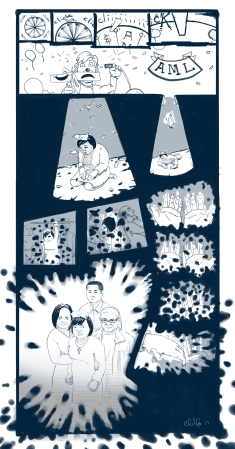
Cheng Ye – Untitled
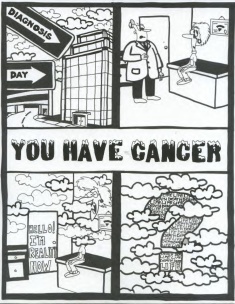
Suzanne Narvaez – untitled
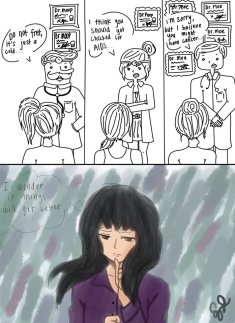
Janira Hernandez – untitled
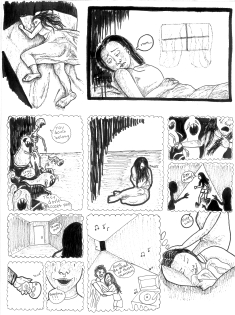
Jenny Yuheng Ning – untitled
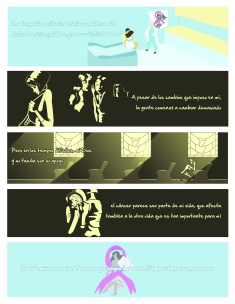
Morris Callegari – Soy Mariana Y Yo Tengo La Victoria
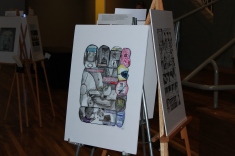
Conference set up – image showing by Nicole DeFrancisco-Untitled
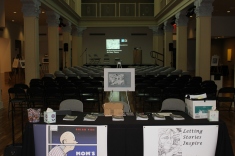
Conference Set up
As the students discussed the narratives with the artists and thought about what they would draw for their own comics, we had long discussions about how inequality was represented. Often we were looking for the big events, where a friend or health profession would make a stigmatizing comment, or someone would be denied access to care. These moments did happen. However, what creating comics forced us to do is to slow down, and not rely on the spectacular moments, but rather to pay attention to the ordinary ways in which inequality is endured cancer diagnosis. As we returned to our cancer narratives, we considered how the women and men who were so generous with their stories had to repeatedly return to the doctors to obtain a diagnosis, multiple stigmatizing moments that blamed them for their diagnosis, how they had to arrange their appointments around all of the other daily obligations they had, and obligations that often made it impossible to receive medical care. Then we had to consider the people, objects and spaces that came to define those moments. Finally, we had to work at assembling the narrator and their context into a visual story. Importantly, we want to ask how these stories connect people to a world that has become so disconnected?
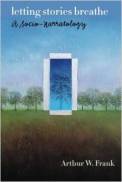
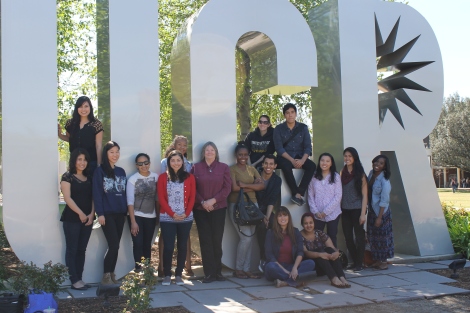
Pingback: Comics in the Community | Teaching Culture·